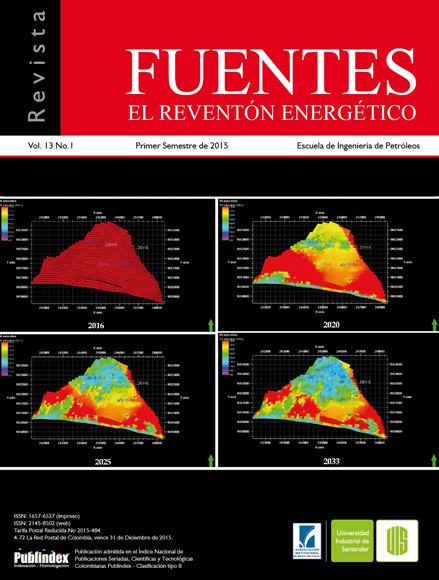Static rock characterization of rocks using X-Ray computed tomography CT
Published 2015-08-11
Keywords
- Computed tomography,
- Static characterization,
- Rock properties
How to Cite
Abstract
X-ray Computed tomography (CT) is now widely used in the study of rocks due to allowing inspection of its internal structure of a non-destructive way and indirect quantification of some of their basic properties. This paper presents a methodology for the acquisition and interpretation of CT images on rocks and calculating their properties, mainly the effective atomic number, bulk density and porosity. The scans are performed on full diameter cores and plugs. The methodology is mainly divided into three sections; in the first one all of the acquisition of images at the laboratory is presented. In the second section the methods of image correction and calculation procedures are exposed.
Finally, in the last section analyzes that can be performed based on the estimated properties of rocks shown.
Downloads
References
2. Bergosh, J., Marks, T., and Mitkus, A. 1985. “New Core Analysis Techniques for Naturally Fractured Reservoirs,” in SPE California Regional Meeting, Bakersfield.
3. Calzado, A., and Geleijns, J. 2010. “Computed Tomography. Evolution, technical and applications,” Revista de Física Médica, pp. 163-180.
4. Coles, M., Muegge, E., Auzerais, F., Frulla, P., and Kantazas, A. 1995. “The Use of Attenuation Standards for CT Scanning,” Special Core Analysis, pp. 1-12.
5. Funk, J., Withjack, E., and Siddiqui, S. 2011. “Core imaging - Twenty five years of equipment, techniques, and applications of X-ray computed tomography (CT) for core analysis,” SCA, vol. 25, no. SCA2001-25, pp. 1-12.
6. Honarpour, M., McGee, K. , Crocker, M., and Maerefat, N. 1986. “Detailed Core Description of a Dolomite Sample from the Upper Madison Limestone Group,” in SPE Rocky Mountain Regional Meeting,, MT.
7. Hunt, P., Engler, P., and Bajsarowicz C. 1988. “Computed tomography as a Core Analysis Tool: Applications, Instrument Evaluation and Image Improvement Techniques,” Journal of Petroleum Technology, pp. 1203-1210.
8. Kantzas, A., and Marentette, D. 1992. “Computerassited tomography: from qualitative visualization to quantitative core analysis,” The Journal of Canadian Petroleoum Technology, vol. 31, no. 9, pp. 48-56.
9. MacGregor, K., Park, E., and Sincock, K 1991. “Effective Unconsolidated Core Preservation in the Arctic Environment:An Aid to Accurate Reservoir Evaluation,” in the International Arctic Technology Conference,
Anchorage.
10. Moss, R., Pepin, G., and Davis L. 1990. “Direct Measurement of the Constituent Porosities in a Dual Porosity Matrix,” in Fourth Annual Technical Conference of the Society of Core Analysts, Dallas.
11. Ramírez, J., Arboleda, C., and McCollugh, C. 2008. “Tomografía computarizada por rayos X: fundamentos y actualidad,” Revista Ingeniería Biomédica, vol. 2, no. 4, pp. 13-31.
12. Schlumberger. 2009. Log Interpretation Charts, Sugar Land, Texas: Sclumberger.
13. Siddiqui, S., and Khamees, A. 2004. “DualEnergy CT-Scanning Applications in Rock Characterization,” SPE, pp. 1-9.
14. Sprunt, E. 1989.”Arun Core Analysis: Special Procedures for Vuggy Carbonates,” The Log Analyst, no. 353.
15. Wellington, S., and Vinegar, H. 1987. “X-Ray Computerized Tomography,” Journal of Petroleum Technology, no. SPE 16983, pp. 885-898.
16. Withjack, E., Devier, C., and Michael, G. 2003. “The Role of X-Ray Computed Tomography in Core Analysis” .
